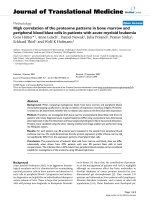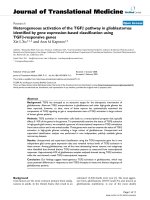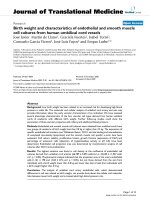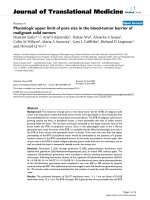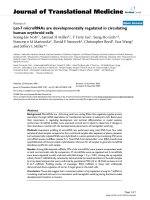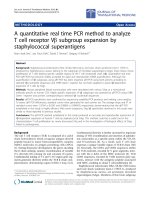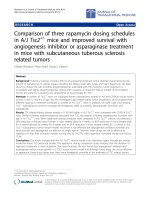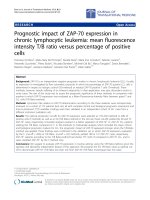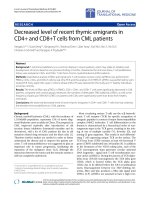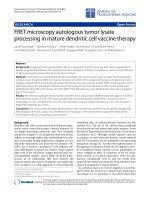Báo cáo hóa học: " FRET microscopy autologous tumor lysate processing in mature dendritic cell vaccine therapy" docx
Bạn đang xem bản rút gọn của tài liệu. Xem và tải ngay bản đầy đủ của tài liệu tại đây (953.67 KB, 6 trang )
Fiammenghi et al. Journal of Translational Medicine 2010, 8:52
/>Open Access
RESEARCH
© 2010 Fiammenghi et al; licensee BioMed Central Ltd. This is an Open Access article distributed under the terms of the Creative Com-
mons Attribution License ( which permits unrestricted use, distribution, and reproduc-
tion in any medium, provided the original work is properly cited.
Research
FRET microscopy autologous tumor lysate
processing in mature dendritic cell vaccine therapy
Laura Fiammenghi
†1
, Valentina Ancarani
†1
, Tilman Rosales
2
, Jay R Knutson
2
, Massimiliano Petrini
1
,
Anna Maria Granato
1
, Elena Pancisi
1
, Laura Ridolfi
1
, Ruggero Ridolfi
1
, Angela Riccobon
1
and Paolo Neyroz*
3
Abstract
Background: Antigen processing by dendritic cells (DC) exposed to specific stimuli has been well characterized in
biological studies. Nonetheless, the question of whether autologous whole tumor lysates (as used in clinical trials) are
similarly processed by these cells has not yet been resolved.
Methods: In this study, we examined the transfer of peptides from whole tumor lysates to major histocompatibility
complex class II molecules (MHC II) in mature dendritic cells (mDC) from a patient with advanced melanoma. Tumor
antigenic peptides-MHC II proximity was revealed by Förster Resonance Energy Transfer (FRET) measurements, which
effectively extends the application of fluorescence microscopy to the molecular level (<100?). Tumor lysates were
labelled with Alexa-488, as the donor, and mDC MHC II HLA-DR molecules were labelled with Alexa-546-conjugated
IgG, as the acceptor.
Results: We detected significant energy transfer between donor and acceptor-labelled antibodies against HLA-DR at
the membrane surface of mDC. FRET data indicated that fluorescent peptide-loaded MHC II molecules start to
accumulate on mDC membranes at 16 hr from the maturation stimulus, steeply increasing at 22 hr with sustained
higher FRET detected up to 46 hr.
Conclusions: The results obtained imply that the patient mDC correctly processed the tumor specific antigens and
their display on the mDC surface may be effective for several days. These observations support the rationale for
immunogenic efficacy of autologous tumor lysates.
Background
Dendritic cells (DC) are the most potent leukocyte popu-
lations which control the primary immune response [1].
As antigen-presenting competent cells, they recognize
and process antigens in the peripheral blood and tissues,
migrate to draining lymph nodes, and finally present anti-
gens to the target resting lymphocytes. Antigens are very
efficiently internalized and processed by immature DC
(iDC), but to achieve a productive T-cell response iDC
must differentiate to mature DC (mDC), which express
high levels of the cell-surface antigen-bearing major his-
tocompatibility complex, class II (MHC II). In the multi-
faceted set of relationships that exist between the
immune system and cancer, therapeutic vaccination has
been accepted as a valid approach to overcoming the
established state of immunotolerance between the two
systems [2,3]. The use of DC, derived from peripheral
blood precursors and pulsed with tumor antigens, forms
the basis of experimental and clinical trials on anti-tumor
vaccinations [4,5]. Although overall response rates for
vaccination are still somewhat limited, results obtained
with DC vaccinations can be considered a very promising
therapeutic strategy [6]. To refine the implementation of
this approach, evaluation of both the DC migration activ-
ity to lymphatic tissues, and the correct presentation of
tumor antigens in MHC II complexes at the DC mem-
brane surface, is of critical importance. From this per-
spective, translational work to link the results from
studies at the cellular and molecular level with those from
clinical investigations is of great interest.
In a previous report, in vivo DC migration was investi-
gated within the context of a clinical trial of anti-tumor
vaccination [7]. In particular, it was shown that mDC
* Correspondence:
3
Department of Biochemistry "G. Moruzzi", University of Bologna in Rimini, Italy
†
Contributed equally
Full list of author information is available at the end of the article
Fiammenghi et al. Journal of Translational Medicine 2010, 8:52
/>Page 2 of 6
exhibit a six- to eightfold higher migration rate than iDC.
Following that study, here we have investigated the
molecular traits of the MHC II complexes of DC from a
melanoma patient pulsed with autologous whole tumor
lysate (ATL).
Our aim was to show that the autologous lysate
(diverse, in character or content of tumor specific anti-
gens, from isolated peptides, but representing the real
"drug") could be processed by the patient's DC and
loaded on the membrane surface as MHCII complexes, a
crucial information for the clinical evaluation of patients
involved in vaccination therapy trials.
Methods
Dendritic cells
Dendritic cells (DC) were prepared as described previ-
ously [6]. Peripheral blood monocytes obtained by leuka-
pheresis without previous mobilization were purified on
Ficoll-Paque gradients (Ge Healthcare Milan, Italy), incu-
bated in tissue culture flasks with CellGro DC medium
(Cell Genix, Freiburg, Germany) at a density of 10
7
cells/
ml for 2 hr, and the adherent cells were incubated in Cell-
Gro DC medium containing 1000 IU/ml rhIL-4 and 1000
IU/ml rhGM-CSF (Cell Genix, Freiburg, Germany) for 7
days. On day 6, the DC culture was pulsed with autolo-
gous tumor lysate (ATL) (100 μg/ml). On day 7, the cells
were defined as immature DC (iDC). After eliminating
the previous culture medium, pulsed iDC were cultured
for a further 2 days with a cocktail of cytokines (TNFα,
IL-1β, IL-6, Cell Genix, Freiburg, Germany; Prostin E
2
,
Pfizer, Puurs, Belgium). On day 9, the cells were defined
as mature DC (mDC). iDC and mDC phenotypes were
determined by single or two-color fluorescence analysis.
ATL preparation and labeling
Surgically removed tumor samples were mechanically
and enzymatically dispersed to create a single-cell sus-
pension in RPMI 1640 (PAA Laboratories GmbH, Pasch-
ing, Austria) and the tumor lysate was prepared as
described previously [6]. Protein concentrations were
determined and aliquots were stored at -80°C until use.
For fluorescence labeling, ATL was reacted with Alexa
Fluor
®
-488 succinimidyl ester (Molecular Probes-Invitro-
gen, USA) according to the supplier's instructions. Size-
exclusion chromatography on Sephadex G-25 superfine
(Ge Healthcare Milan, Italy) was used to separate the
bound from the free dye. Analytical sodium dodecyl sul-
phate polyacrylamide gel electrophoresis (SDS-PAGE) on
gradient (4%-20%) was performed to evaluate the protein
content of ATL and the goodness of the fluorescence
labeling.
Immunofluorescence
Cells (3 × 10
5
), pulsed with ATL-Alexa488 (80 μg/10
6
DC), were plated on coverslips pretreated with poly-D-
lysine (Sigma Milan, Italy) and fixed with several drops of
cold methanol at -20°C for 2 min. Cells were stained with
mouse monoclonal HLA-DR (HL12) primary antibody
(Santa Cruz, CA, USA) (1:100), followed by Alexa Fluor
®
-
546 goat anti-mouse IgG (Molecular probes, Invitrogen)
(1:2000).
Confocal FRET measurements
Image acquisition and FRET efficiency by acceptor pho-
tobleaching measurements [8] were performed using a
Leica TCS SP5 equipped with an argon ion and a DPSS
laser with output lines at 488 nm and 561 nm, respec-
tively. All samples were imaged with a Leica Plan Apo 63
× 1.4 oil immersion lens. FRET was resolved from the
increase of donor fluorescence in the bleached region of
interest (ROI). Data analysis was accomplished by the
Leica software application for acceptor photobleaching,
and the energy transfer efficiency was calculated accord-
ing to equation 1 as:
where D
postbleach
is the fluorescence intensity of the
donor after photobleaching and D
prebleach
is the fluores-
cence intensity of the donor before photobleaching. As a
control, non-bleached areas were also analyzed for FRET.
Before- and after-photobleaching, images were acquired
by simultaneous excitation with 488 nm and 561 nm laser
lines at 5% and 9% of the total power intensity, respec-
tively. Photobleaching was obtained by scanning in a
zoomed region, over six vertical Z sections, with the 561
nm excitation laser line at 100% of its power intensity.
Results
Immunofluorescence
The tight regulatory control of peptide-MHC II complex
formation in DC have been dissected and clearly
described in prior fundamental biological studies [9-11].
In particular, it has been shown that effective presenta-
tion of peptide-MHC II complexes requires DC matura-
tion and that this final differentiation is a major control in
priming T cells in vivo. Due to the impact of this finding
on the optimal use of DC in cancer immunotherapy, as an
adjunct to a phase I/II clinical trial on advanced mela-
noma patients we explored the potential transfer of ATL
peptides to MHC II complexes at the DC plasma mem-
brane as a function of time after maturation. In Figure 1A
a summary scheme of the experimental plan is presented.
iDC were pulsed with Alexa488-labeled ATL for 16 hr
and, after the wash out of lysate, matured with a standard
cytokine cocktail (see Methods). At increasing times (2-
46 hr) from the maturation stimulus, mDC HLA-DR
molecules were immunolabelled with Alexa546-biocon-
jugated IgG, and double fluorescence stained cells were
EDDD(%) ( ) /×= −100
postbleach prebleach postbleach
Fiammenghi et al. Journal of Translational Medicine 2010, 8:52
/>Page 3 of 6
analyzed by confocal microscopy to reveal FRET. In Fig-
ure 1B the gel electrophoresis analysis of a typical ATL -
Alexa488 labeling procedure is shown, while in Figure 1C
the characteristic mDC images obtained at 16 hr and 46
hr after the maturation stimulus are presented.
FRET measurements
In FRET experiments a donor and an acceptor are defined
by the overlap between the emission spectrum of the first
and the excitation spectrum of the second. An excited
donor will return to the ground state through an acceptor
via FRET provided that the acceptor molecule is in close
vicinity (<~80Å). In our experimental design, Alexa488-
ATL molecules represent the donor and Alexa546-(AbII-
AbI)-HLA-DR represent the acceptor. Under these condi-
tions, detection of FRET is an accurate signature of prox-
imity (requiring physical interaction) between ATL
peptides and HLA-DR molecules. The efficiency of FRET
is strongly distance dependent, so overall FRET efficien-
cies will have an upper limit set by the distance of closest
approach between the ATL dye and the dye on the sec-
ondary antibody.
FRET efficiency measurements obtained for mDCs at
16 hr and 46 hr after the maturation stimulus are pre-
sented in Table 1. The overall FRET efficiency of mDC
examined 46 hr after maturation was significantly higher
than that measured after 16 hr. In the table this evidence
is clearly indicated by the changes in intensity levels of
the Donor Pre and the Donor Post columns, respectively.
Figure 1 Experimental plan and fluorescence images. (A) Scheme of the experimental plan. (B) SDS-PAGE analysis of ATL. Proteins gel electropho-
resis separation was run on acrylamide gradient (4%-20%). The ATL sample is shown after Coomassie brilliant Blue staining of the proteins bands (lane
1) and by UV transillumination, before staining of the proteins bands, to reveal the extent of the fluorescence labelling (lane 2). (C) FRET analysis of
mDC loaded with Alexa488-labeled ATL and immunolabelled with HLA-DR(HL12) mAb and Alexa546-conjugated IgG. The upper panels refer to the
sample analyzed at 16 hours after the maturation stimulus and the lower panels refer to the sample analyzed at 46 hours after the maturation stimulus.
Panels are divided in sets of images acquired before and after acceptor photobleaching (see Materials and Methods). Donor images were acquired in
the green channel (a, h, d and k) and acceptor images were acquired in the red channel (b, i, e and l). White arrows (e and l) indicate the bleached
regions. The relative merged images are also shown (c, j, f and m). FRET efficiency was calculated using eq. 1 and the results are presented as pseudo-
color images (g and n).
abcdef
hi j k
l
m
before bleaching
after bleaching
g
n
B
1 2
10
200
66
41,5
21
M.W. (kD)
A
16 hr
46 hr
16 hr
46 hr
iDC mDC
Alexa488-ATL
“pulsing”
(16 hrs)
(TNF, IL-1, IL-6, PGE
2
)
maturation
stimulus
Alexa546-(AbII-AbI)-HLA-DR
immunolabelling
microscopy
(FRET)
C
sample collection
(2-46 hrs)
Fiammenghi et al. Journal of Translational Medicine 2010, 8:52
/>Page 4 of 6
We confirmed this observation by studying the FRET
efficiency of mDC for 2 hr to 46 hr after the maturation
stimulus (Figure 2A). Although HLA-DR molecules were
found concentrated at the dendritic cell plasma mem-
brane even shortly after maturation (≤4 hours, data not
shown), no significant proximity with the ATL antigens
was detected up to 16 hr. However, from 16 to 22 hr, a
steep increase of FRET was revealed, and the trend con-
tinued upwards up to 46 hr. These results suggest that
specific tumor antigen peptides are transferred to MHC
II complexes, and that this process is significant 22 hr
after maturation. Moreover, the data also confirms that
antigen presentation is still fully effective after 46 hr.
FRET efficiency analysis
It should be noted that in extremely (donor or acceptor)
overloaded cells, FRET might sometimes be detected as a
result of accidental proximity due to surface density-
dependent interactions [12-14]. To be certain our FRET
results heralded true proximity, we tested FRET levels
versus loading on a pixel by pixel basis. Any "artifactual"
FRET from overloading should be strongly correlated
with levels per pixel. Under our experimental conditions,
the total tumor lysate fluorescence (donor), complexed at
the mDC membrane surface, should be intrinsically
depleted due to the intracellular antigen degradation and
processing events. For this reason, we assumed that only
the MHC II molecules (acceptor) could represent a
source of artifactual FRET.
Figure 2B shows a plot of the acceptor levels versus
FRET efficiency. This analysis strongly indicates that E%
is independent of acceptor levels, and thus negates inter-
pretations that sever the link between FRET efficiency
and tumor lysate peptide-MHC II proximity.
Discussion
Proof of the specific activation of immune responses is
crucial in the overall rationale of cancer immunotherapy,
and, more specifically, it is needed to convincingly
address any analysis of immunogenic efficacy. In the pres-
ent work we evaluated the presentation of ATL peptides
onto MHC II of mDC from a patient with advanced mela-
noma.
The pattern of the protein content of ATL has been pre-
sented in Figure 1B together with the result of its homo-
geneous fluorescence labeling. These products were used
previously to monitor the uptake and the processing of
ATL in DC by fluorescence microscopy imaging [15].
Here, the antigens (ATL) and antigen-capturing mole-
cules (MHC II) were tagged to act as donor-acceptor
pairs, and FRET measurements were performed to
resolve the physical interactions between ATL and MHC
II. Under these conditions, our results indicate a signifi-
cant correlation between FRET efficiency and the time
after maturation stimulus (Figure 2A). This observation is
consistent with an increasing transfer of ATL peptide-
loaded MHC II molecules on the mDC membrane. This
process is significant 22 hr after maturation, and antigen
presentation remains fully effective after 46 hr. The
Table 1: mDC FRET efficiency measured 16 hr and 46 hr after maturation stimulus
mDC 16 hr ROI 1 ROI 2 ROI 3 ROI 4 ROI 5 ROI 6
Donor Pre 33 23 26 25 29 46
Donor Post 34 23 25 26 28 45
Acceptor Pre 46 59 60 47 35 74
Acceptor Post 88763372
E (%) 2.94 0 0 3.85 0 0
mDC 46 hr ROI 1 ROI 2 ROI 3 ROI 4 ROI 5 ROI 6
Donor Pre 31 45 43 41 37 44
Donor Post 36 62 52 49 37 42
Acceptor Pre 56 142 132 142 139 133
Acceptor Post 7988141139
E (%) 13.9 27.4 17.3 16.3 0 0
ROI, Region of interest; Pre, before photobleaching; Post, after photobleaching; mDC 16 or 46 hr, Dendritic Cells matured for 16 or 46 hr; E
(%), Energy Transfer Efficiency. The data shown refer to six significant ROIs of the experiments reported in Figure 1A. ROI1 to ROI4 represent
regions selected within the bleached area, whereas ROI5 and ROI6 represent regions selected outside the bleached area, which were used as
controls. The numbers in the "Donor" and the "Acceptor" rows indicate the fluorescence intensity levels detected in each ROI.
Fiammenghi et al. Journal of Translational Medicine 2010, 8:52
/>Page 5 of 6
kinetic response observed is in excellent agreement with
those reported on the transport of specific HEL-peptide-
MHC II complexes at the DC surface [9], and the accu-
mulation of MHC II complexes on mDC induced by
inflammatory stimuli [10]. Yet, in accord with these
reports, the apparent discrepancy between the high levels
of acceptor fluorescence and the absence of FRET detec-
tion shortly after maturation (≤4 hours), could possibly be
related to the rapid turnover of unloaded MHC II mole-
cules observed in developing DCs.
In Figure 2B we addressed the potential effects of MHC
II density over FRET by plotting acceptor levels versus the
efficiency, E%. This test was developed to study the distri-
bution of proteins at the apical surface of MDCK cells
[14]. In particular, in the appendix of that survey, the the-
oretical dependence of FRET was separated into random
or clustered distribution of donor- and acceptor-labeled
molecules. It was clearly shown that the clustered model
predicts that the efficiency will be independent of the
surface densities of the labeled molecules. As mentioned
above, given that newly synthesized class II molecules are
produced in increased amounts in the first 24 hours after
maturation [10], in our study we were particularly cau-
tious about the FRET detection bias due to acceptor over-
crowding [12]. In this respect, a more distinctive feature
of MHC II organization on the plasma membrane of DC
was elucidated recently by Unternaehrer and coworkers
[16] in which MHC II molecules were found to cluster by
a lateral association mediated mechanism.
In our study, the independence of E% from acceptor
levels (random distribution of E%) clearly indicates the
absence of a nonspecific density contribution to FRET
and fits the clustered model. Thus, we assign the signifi-
cant increase of FRET efficiency, observed at the mem-
brane surface as a function of time from maturation, to
the actual transfer of specific tumor antigen peptides into
MHC II clustered complexes.
This single-case survey on an advanced melanoma vac-
cination trial shows that autologous tumor lysates are
correctly processed and presented at the mDC mem-
brane surface in melanoma patients. In addition, this
time-dependent profile is consistent with a delayed mDC
antigen display, a property that is crucial for their role in
vaccination-triggered immune surveillance [17]. Yet, the
methodology described and the parameters obtained (i.e.
FRET signals) can be applied to follow-up studies to ana-
lyze and evaluate their prognosis value in addressing the
efficacy of immunotherapy protocols.
Finally, it is worth commenting on the potential wealth
of information that could be gleaned from FRET mea-
surements when maximal FRET efficiency is known. In
favorable circumstances, a quantitative data analysis
approach is possible (i.e. a measure of the absolute
changes in the amounts of antigen-loaded MHC II mole-
cules at the DC membrane surface). Unfortunately, this
information can only be obtained from extensive studies
where appropriate standards are available (i.e. oligonu-
cleic acid hybrids, streptavidin-biotin coupled donor-
acceptor pairs) [18], or when specific tagged molecules
can be engineered [12]. Under our particular experimen-
tal conditions, we could not define the maximal FRET
efficiency of the investigated donor-acceptor system
(Alexa488-ATL - Alexa546-(AbII-AbI)-HLA-DR). Addi-
tional "semi-quantitative" data interpretation would be
affected by large approximations, and would also rely on
uncertain assumptions. Nonetheless, the measured rela-
tive changes of FRET efficiency with time from matura-
tion are intrinsically significant and relevant for the
clinical evaluation of immunotherapy vaccination trials.
It has to be pointed out that we chose the acceptor pho-
tobleaching FRET method for its complete insensitivity
to certain artifacts, including the direct excitation of
acceptor. According to this FRET measurement method,
Figure 2 FRET measurements. (A) Averaged FRET efficiency of mDC
as a function of time from the maturation stimulus. The data and the
Standard Errors (±SE) refer to FRET measurements performed over at
least three fields for each sample (n = 3-5) and different ROIs (n = 30-
55) inside the bleached regions. The x axis displays the time in culture
after maturation stimulus. (B) Plot of the independence of E% from ac-
ceptor levels. The data shown were generated from image measure-
ments 22 hr after maturation. The acceptor levels refer to the intensity
of the image acquired before acceptor photobleaching and analyzed
versus the recovered E%, on a pixel by pixel basis.
Fiammenghi et al. Journal of Translational Medicine 2010, 8:52
/>Page 6 of 6
both of the images (i.e. the green and in the red channels)
were acquired before and after photobleaching through
the appropriate emission barrier filters. Moreover, for
each sample, three different staining preparations were
carried out: +Alexa488 -Alexa546; +Alexa488 +Alexa546;
-Alexa488 +Alexa546. All the sample preparations were
analyzed before the active photobleaching FRET mea-
surements. Under our experimental conditions, no signif-
icant background of Alexa 546 excitation in the absence
of Alexa488 was observed. Furthermore, the test pre-
sented in Figure 2B (acceptor levels vs. E%) was weighted
against the presence of crosstalk artifacts.
Conclusions
Using confocal microscopy FRET [8] we have been able to
detect the transfer of specific peptides into MHC II com-
plexes at the membrane surface of mDC. Moreover, the
profile of the appearance of MHC II - tumor lysate anti-
gen complexes, as a function of time after the maturation
stimulus, is in good agreement with the results from pre-
vious biological studies on mouse [9] and human DC
[10]. In conclusion, our findings suggest that, in cancer
vaccination immunotherapy procedures: i) autologous
tumor lysates are correctly processed by DC in vitro and
ii) the resulting antigenic peptides are properly loaded on
mDCs' MHC II complexes. This study reinforces the
rationale behind the immunogenic efficacy of cancer vac-
cination treatments.
Abbreviations
ATL: Autologous Tumor Lysate; DC: Dendritic Cell; E%: Energy Transfer Effi-
ciency; FRET: Förster Resonance Energy Transfer; HLA-DR: human leukocyte
antigen DR; MHCII: major histocompatibility complex class II; ROI: Region of
interest. SDS-PAGE: sodium dodecyl sulphate polyacrylamide gel electrophore-
sis.
Competing interests
The authors declare that they have no competing interests.
Authors' contributions
LF and VA carried out the ATL conjugation and cell sample preparations, partic-
ipated in the study design and drafted the manuscript; TR participated in FRET
measurements; MP, AMG, AR and EP performed in vitro culturing of dendritic
cell vaccines; RR and LR performed the therapeutic treatments; JRK partici-
pated in analysis and interpretation of data and in manuscript revision; PN con-
ceived the study, coordinated the groups, performed FRET measurements, and
edited the manuscript. All authors read and approved the final manuscript.
Acknowledgements
The authors wish to thank Dr. Sundararajan Venkatesan and Dr. Ling Yi from the
National Institute of Allergy and Infectious Diseases (NIH, Bethesda, USA) for
helpful discussion and assistance in running the Leica SP5 TCS confocal appa-
ratus. This project was supported by the Research Program of the Polo Scientif-
ico - Didattico di Rimini, RFO 2007 at the University of Bologna, and was
partially funded by Compagnia di San Paolo, Torino. The authors also wish to
thank Dr. Ian Seymour for editing the manuscript.
Author Details
1
Immunotherapy and Somatic Cell Therapy Laboratory, Istituto Scientifico
Romagnolo per lo Studio e la Cura dei Tumori (I.R.S.T.) Meldola, Italy,
2
Laboratory of Molecular Biophysics, National Heart, Lung and Blood Institute,
National Institutes of Health, Bethesda, USA and
3
Department of Biochemistry
"G. Moruzzi", University of Bologna in Rimini, Italy
References
1. Hart DN: Dendritic cells: unique leukocyte populations which control
the primary immune response. Blood 1997, 90:3245-3287.
2. Banchereau J, Palucka AK, Dhodapkar M, Burkeholder S, Taquet N, Rolland
A, Taquet S, Coquery S, Wittkowski KM, Bhardwaj N, Pineiro L, Steinman R,
Fay J: Immune and clinical responses in patients with metastatic
melanoma to CD34(+) progenitor-derived dendritic cell vaccine.
Cancer Res 2001, 61:6451-6458.
3. Ichim CV: Revisiting immunosurveillance and immunostimulation:
Implications for cancer immunotherapy. J Transl Med 2005, 3:8.
4. O'Neill DW, Adams S, Bhardwaj N: Manipulating dendritic cell biology for
the active immunotherapy of cancer. Blood 2004, 104:2235-2246.
5. Banchereau J, Palucka AK: Dendritic cells as therapeutic vaccines against
cancer. Nat Rev Immunol 2005, 5:296-306.
6. Ridolfi R, Petrini M, Fiammenghi L, Stefanelli M, Ridolfi L, Ballardini M,
Migliori G, Riccobon A: Improved overall survival in dendritic cell
vaccination-induced immunoreactive subgroup of advanced
melanoma patients. J Transl Med 2006, 4:36.
7. Ridolfi R, Riccobon A, Galassi R, Giorgetti G, Petrini M, Fiammenghi L,
Stefanelli M, Ridolfi L, Moretti A, Migliori G, Fiorentini G: Evaluation of in
vivo labelled dendritic cell migration in cancer patients. J Transl Med
2004, 2:27.
8. Bastiaens PIH, Jovin TM: Fluorescence resonance energy transfer (FRET)
microscopy. In Cell biology: a laboratory handbook 3rd edition. Edited by:
Celis JE. New York, Academic Press; 1998:136-146.
9. Turley SJ, Inaba K, Garrett WS, Ebersold M, Unternaehrer J, Steinman RM,
Mellman I: Transport of peptide-MHC class II complexes in developing
dendritic cells. Science 2000, 288:522-527.
10. Cella M, Engering A, Pinet V, Pieters J, Lanzavecchia A: Inflammatory
stimuli induce accumulation of MHC class II complexes on dendritic
cells. Nature 1997, 388:782-787.
11. Inaba K, Turley S, Iyoda T, Yamaide F, Shimoyama S, Reis e Sousa C,
Germain RN, Mellman I, Steinman RM: The formation of immunogenic
major histocompatibility complex class II-peptide ligands in lysosomal
compartments of dendritic cells is regulated by inflammatory stimuli.
J Exp Med 2000, 191:927-936.
12. Vogel SS, Thaler C, Koushik SV: Fanciful FRET. Sci STKE 2006, 2006:re2.
13. Wallrabe H, Elangovan M, Burchard A, Periasamy A, Barroso M: Confocal
FRET microscopy to measure clustering of ligand-receptor complexes
in endocytic membranes. Biophys J 2003, 85:559-571.
14. Kenworthy AK, Edidin M: Distribution of a glycosylphosphatidylinositol-
anchored protein at the apical surface of MDCK cells examined at a
resolution of <100 A using imaging fluorescence resonance energy
transfer. J Cell Biol 1998, 142:69-84.
15. Ancarani V, Fiammenghi L, Petrini M, Pancisi E, Ridolfi L, Ridolfi R, Riccobon
A, Neyroz P: Fluorescence microscopy imaging to monitor dendritic
cell's tumor lysate capturing and processing: preliminary data
[abstract]. Italian J Biochem, Special Issue 2007, 129:.
16. Unternaehrer JJ, Chow A, Pypaert M, Inaba K, Mellman I: The tetraspanin
CD9 mediates lateral association of MHC class II molecules on the
dendritic cell surface. Proc Natl Acad Sci USA 2007, 104:234-239.
17. Gilboa E: DC-based cancer vaccines. J Clin Invest 2007, 117:1195-1203.
18. Lim TC, Bailey VJ, Ho Y-P, Wang T-H: Intercalating dye as an acceptor in
quantum-dot-mediated FRET. Nanotechnology 2008, 19:075701. (7pp)
doi: 10.1088/0957-4484/19/7/075701
doi: 10.1186/1479-5876-8-52
Cite this article as: Fiammenghi et al., FRET microscopy autologous tumor
lysate processing in mature dendritic cell vaccine therapy Journal of Transla-
tional Medicine 2010, 8:52
Received: 14 December 2009 Accepted: 3 June 2010
Published: 3 June 2010
This article is available from: 2010 Fiammenghi et al; licensee BioMed Central Ltd. This is an Open Access article distributed under the terms of the Creative Commons Attribution License ( which permits unrestricted use, distribution, and reproduction in any medium, provided the original work is properly cited.Journal of Tr anslational Medi cine 2010, 8:52
